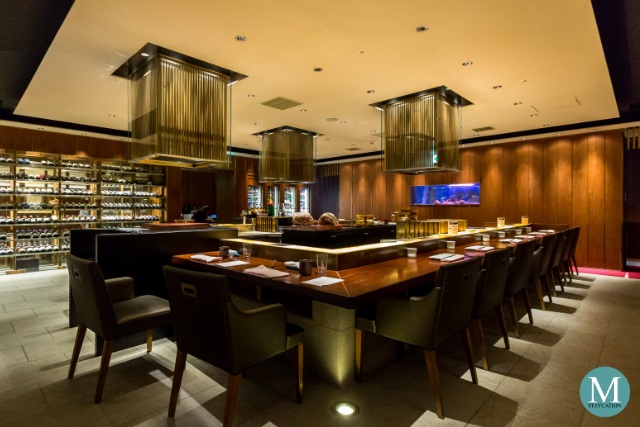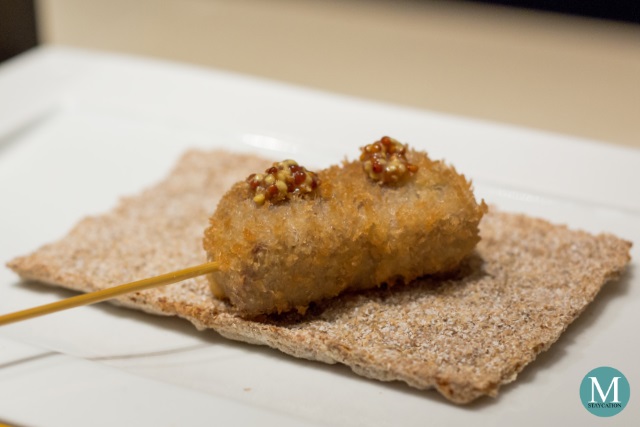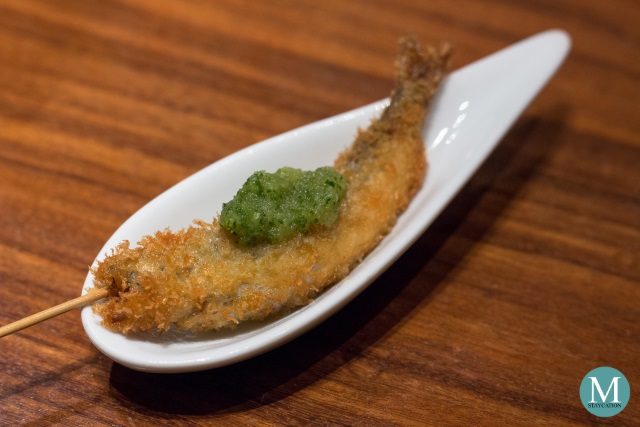
SH'UN is a Japanese restaurant at Swissôtel Nankai Osaka specializing in Kushiage, the Osaka specialty dish made of premium meats and seasonal ingredients. The restaurant also serves tapas-style dishes which are best paired with wine from their award-winning wine list.

Kushiage is made of meats and vegetables skewered on kushi (bamboo sticks), dipped in a mixed batter of eggs and flour, coated with panko (Japanese breadcrumbs), and finally deep-fried until golden brown. Kushiage is said to originate from Osaka, making it one of the not-to-be-missed experiences when staying at Swissôtel Nankai Osaka.
 |
| Chef Junya Ishihara | SH'UN, Swissôtel Nankai Osaka |
Here at SH'UN, the best way to experience Kushiage is by ordering one of the restaurant's seasonal set menus available during lunch and dinner. You can also order individual items from the a la carte menu. Responsible for planning the seasonal menus is Chef Junya Ishihara who has been working at SH'UN since 2007.
 |
| Amuse-Bouche | Menu SH'UN |
During my recent stay at Swissôtel Nankai Osaka, I dined with my friend Angela at SH'UN for dinner. There are three set menus for dinner: Menu Traditional (with 7 Kushiage selection), Menu Fusion (with 10 Kushiage selection), and the Menu SH'UN (with 14 Kushiage selection). We opted for the Menu SH'UN which included an Amuse-Bouche, Vegetable Sticks, Homemade Bread, Selection of 14 Kushiage, a Rice Dish, and Dessert.
 |
| Vegetable Sticks | Menu SH'UN |
Both the Amuse-Bouche and the Vegetable Sticks feature seasonal summer crops from Japan and Europe such as okra, radish, carrot, sweet Palermo peppers, elephant foot taro, collinky squash, eggplant, Aiko tomato, and Italian chicory. Some of the vegetables are available year-round, but it is during summer when they are the sweetest. The vegetables were very crunchy and their refreshing taste makes them a good side-dish while eating the kushiage.
 |
| Tiger Prawn Kushiage | Menu SH'UN |
Tiger Prawn Kushiage - the first kushiage served to us was the tiger prawn. It was lightly battered and the meat was very tender and juicy. The head and claws were very crispy and can also be eaten. It is best eaten without any seasoning to enjoy the fresh flavor of the prawn.
 |
| Yanaka Ginger Wrapped with Pork Kushiage | Menu SH'UN |
Yanaka Ginger Wrapped with Pork Kushiage - the next kushiage was made of Yanaka ginger which was wrapped with pork. Yanaka ginger is a small-size ginger with a very mild taste. It is usually eaten raw in Japan. The taste of the ginger and of the pork complement each other.
 |
| White Corn Kushiage | Menu SH'UN |
White Corn Kushiage - The third kushiage served to us was a simple kushiage made of white corn. Corn is a seasonal summer crop in Japan, and Japanese corn, especially those from Hokkaido, is known for its delicious sweetness. Corn in Japan has soft skin kernel and can be eaten fresh, but cooking it can elevate its sweetness.
 |
| Tokishirazu Summer Catch Salmon Kushiage | Menu SH'UN |
Tokishirazu Summer Catch Salmon Kushiage - The next kushiage served was made with Tokishirazu salmon, which is a very rare wild salmon caught in the seas of Northern Japan between spring and summer seasons. Tokishirazu salmon is popular for its plump and lean meat and its sweet taste. It is one of the most expensive salmon in Japan and you can only experience this kind of kushiage in high-end Japanese restaurants like SH'UN.
 |
| Ōmi Beef Kushiage topped with Mustard | Menu SH'UN |
Ōmi Beef Kushiage Topped with Mustard - Another premium quality kushiage was served. This time, it was made with Ōmi beef, which is a type of wagyu beef from Japan's Shiga prefecture. Ōmi beef is considered one of the three top brands of wagyu beef in Japan. This kushiage is made with two chunks of beef and topped with mustard seeds. The meat was very tender and easy to bite. The mustard seeds only had a mild taste that didn't overpower the beef flavor.
 |
| Black Sesame Kuzu Tofu Kushiage | Menu SH'UN |
Black Sesame Kuzu Tofu Kushiage - This kushiage is made with kuzu tofu. Kuzu tofu has the same silky consistency with tofu, but kuzu tofu is made with kuzu (arrowroot) and sesame paste. The kuzu tofu used in the kushiage is made with black sesame which also dominates the overall taste of the tofu.
 |
| Eggplant Wrapped with Beef Kushiage | Menu SH'UN |
Eggplant Wrapped with Beef Kushiage - The next kushiage is made with sweet eggplant wrapped with strips of beef. What made this kushiage special was the dipping sauce it was served with. The sauce was made with sansho (Japanese peppers) which are harvested in the neighboring Kyoto during spring and summer. It had a mild citrusy and lightly tangy taste with a numbing sensation to the tongue.
 |
| Strawberry Sorbet | Menu SH'UN |
Midway through our meal, we were served with Strawberry Sorbet. Usually served as dessert, sorbet can also be served in the middle of the meal to cleanse the palate and prepare the taste buds for the next dishes. This European tradition was applied in this Japanese meal in keeping with the Swissôtel brand of service.
 |
| Japanese Seaperch and Mozzarella Kushiage with Gazpacho | Menu SH'UN |
Japanese Seaperch and Mozzarella Kushiage with Gazpacho - The next kushiage was a playful twist to fried Mozzarella balls which was given a Japanese twist adding seaperch meat and coated with Japanese breadcrumbs. The kushiage was served in a bed of cold Spanish Gazpacho. Again, we see how SH'UN creatively combines European and Japanese cuisines.
 |
| Ayu from the Lake Biwa Kushiage | Menu SH'UN |
Ayu from the Lake Biwa Kushiage - Ayu, also called sweetfish in English, is the most beloved freshwater fish in Japan, and no summer in Japan is complete without eating ayu. SH'UN uses wild ayu caught from Lake Biwa, the largest freshwater lake in Japan. Ayu has a very aromatic yet very mild flavor. When cooked, the ayu kushiage can be eaten from head to tail. The ayu kushiage is then topped with pureed cucumber to give it a refreshing taste.
 |
| Hokkaido Octopus Kushiage with Vinegared Mozuku Seaweed | Menu SH'UN |
Hokkaido Octopus Kushiage with Vinegared Mozuku Seaweed - This kushiage may look ordinary but it has an interesting story. On the one hand, the octopus used here is from Hokkaido. The waters of this northernmost prefecture of Japan is where the best wild octopuses in Japan are caught. On the other hand, the kushiage is served in a bed of vinegared Mozuku seaweed from Okiwana, Japan's southernmost prefecture. North meets South in this kushiage dish, creating a smooth blend of the flavors of the ocean with contrasting textures of crunchiness and chewiness from the kushiage, and sliminess from the Mozuku seaweed.
 |
| Scorched Anago (Japanese Conger) Kushiage | Menu SH'UN |
Scorched Anago Kushiage - Another summer delicacy in Japan is anago or Japanese conger. These saltwater eels are traditionally eaten as tempura or as tendon, especially in the Tokyo area. But in Osaka, the best way to enjoy anago is by cooking it as kushiage, especially during summer. The anago meat is very tender and fluffy, and the juiciness is locked in the flesh.
 |
| Soybean Dumpling Kushiage | Menu SH'UN |
Soybean Dumpling Kushiage - This kushiage reminds me of kushi dango from Kyoto which are balls made with rice flour. This one is made with soybean flour and is then coated with batter and fried into a kushiage. It has a chewy texture with a slight sweetness.
 |
| Japanese Brand Pork and Leek Kushiage | Menu SH'UN |
Japanese Brand Pork and Leek Kushiage - A piece of cubed leek is placed in between two chunks of pork before dip-frying into kushiage. The cooking process is slightly longer to ensure that the meat was cooked evenly. This resulted in the golden-brown color of the kushiage. It was recommended to add a little mustard on the kushiage to bring out the flavor of the pork.
 |
| Amate Karei and Sengoku Mame Kushiage | Menu SH'UN |
Amato Karei and Sengoku Mame Kushiage - The last kushiage served to us was made with amato karei (Japanese flatfish) which is another popular fish in Japan during summertime, and sengoku mame (sengoku beans or Japanese hyacinth beans). Filleting the fish itself is very laborious due to the fish's tough and slimy skin and hard bones. The meat of the amato karei is very tender and has a slightly sweet taste which complements the natural sweetness of the sengoku mame.
 |
| Rice Dish | Menu SH'UN |
The last dish to be served to us was a bowl of steamed rice cooked with plum and Japanese ginger which was then topped with grated yum and grilled unagi (freshwater eel). Unagi is also popular during summertime. There are many ways to enjoy unagi, but grilled unagi is the most popular among the Japanese. Unagi is more fatty than its saltwater counterpart, the anago. This particular grilled unagi was very flavorful and crunchier. I loved its sweet soy glazing which went well with the starchy and slightly creamy steamed rice.
 |
| Seasonal Fruits |
We ended our meal with assorted seasonal fruits. The watermelon was very sweet and juicy while the peaches were sweet and refreshingly tart. I was surprized that even the blueberries were sweet and not sour. Japan is truly blessed with the sweetest fruits.

Overall, I enjoyed my Kushiage experience at SH'UN. Kushiage taught me how the Japanese make use of the most abundant crops and catch in a particular season, and turning them into simple yet flavorful dishes. With ingredients sourced from around Japan, eating kushiage at SH'UN was like visiting and learning about different regions in the country.

I very curious to learn about other seasonal ingredients in Japan and I wonder how Chef Junya Ishihara will interpret them into kushiage. Having said that, I will definitely dine here again if I get the chance to visit Osaka again during a different season. The months between autumn and winter seem to be an interesting time to visit Osaka again, don't you think?
SH'UN
Lobby Level, Swissôtel Nankai Osaka
5-1-60 Namba Chuo-ku, Osaka, 542-0076, Japan
Contact: +81 6 6646-1111
Email: osaka@swissotel.com
Website | Facebook | Instagram
No comments:
Post a Comment